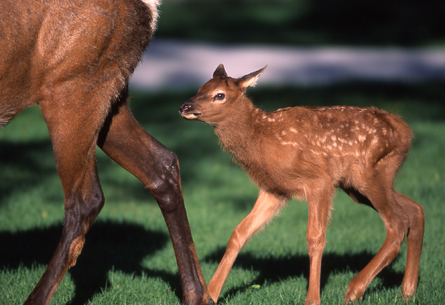LARAMIE, Wyo. — Warming temperatures could help explain why migration isn’t such a hot idea anymore for some elk living in and around Yellowstone National Park.
About a third of what’s called the Clarks Fork elk herd moves at the end of winter from land around Cody, Wyo., up to grasslands at high elevations in Yellowstone, said ecologist Arthur Middleton of the University of Wyoming in Laramie. When the flush of summer greenery ends and the fierce high-elevation winter nears, these elk return to lower elevations.

Migration supposedly lets animals follow the best food of the season, Middleton said. But the migratory elk are dwindling in number, while the stay-behind part of the herd grows.
Migration is dwindling worldwide, Middleton says, and preserving some of the last large mammal migrations in North America has become a key conservation concern.
Satellite images of where the elk roam now suggest what’s gone wrong with their migration, Middleton reported June 14 at the annual meeting of the American Society of Mammalogists.
Images show that the period when grasslands are thriving and green with prime nutrition for grazers shrank by 40 percent between 1989 and 2009, he said.
This premature grassland brownout fits with weather station data showing that over the past 21 years, the average July temperature in the migrants’ high-elevation summer range has risen more than 4 degrees Celsius, Middleton said. On top of that, nearly a decade of drought worse than the Dust Bowl dry-out has parched the Yellowstone region.
In contrast, satellite images show little change in the greening of vegetation at the lower elevation, Middleton said. Elk remaining there not only have a more stable summer food source, but can nip over to some scattered agricultural outfits to take advantage of irrigated vegetation.
Skimpy food offerings in the high grasslands could help explain why calf production declined by 70 percent among the Clarks Fork migratory elk between 1989 and 2009, Middleton said. Now only about two-thirds of the adult Clarks Fork females get pregnant each year, compared with about 90 percent of the nonmigratory females in the same herd. With sparser rations during the summer, fewer migratory females seem able to manage both tending a calf and breeding again each year.
Researchers have also found that adult male elk seem to have become more vulnerable to wolves early in the winter than they used to be, said Douglas Smith, who directs wolf research and management in Yellowstone.
Predators do play a role in elk numbers, and Middleton said that migratory elk are likely to be hit harder than sedentary ones. He noted that Yellowstone National Park reports growing numbers of grizzly bears, which prey considerably upon elk calves, as well as elk-hunting wolves. The park protects predators from hunters, but where the nonmigratory elk summer, predators get killed if they menace livestock.
So the elk migration flunks on two counts, Middleton said. It provides neither seasonal food bonanzas nor relief, even temporarily, from predators.
Other upslope migrants may face similar troubles, Middleton speculated. People tend to concentrate agriculture, with its irrigation and low tolerance for predators, at low altitudes, while parks often end up in the harder-to-develop heights.






